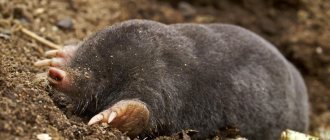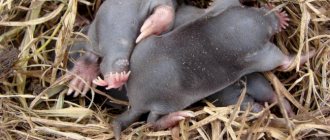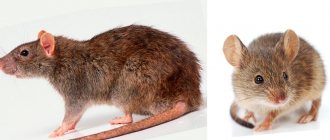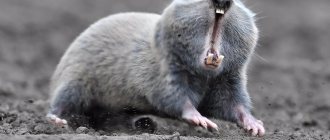Where does the mole live?
The mole is a dungeon animal. He has poorly developed vision, but is well oriented thanks to his sense of smell and hearing. He prefers familiar depth rather than sun and bright light. If by chance a mole gets to the surface, it backs away and tries to get back into its hole.
The mole on the surface: surprised and discouraged.
Lifestyle Features
Moles are predatory animals. They prefer mollusks, bugs, worms and other small animals. Hungry animals may covet small rodents, and angry animals may covet other moles. That is why their constant search for food does not stop.
This kind of nutrition also ensures the rodent’s lifestyle - it builds itself a special home with a place to rest, supplies and various passages.
Ever seen a live mole?
Never happened
Where do they live?
The animals live mainly in humid areas: river floodplains, forest edges, meadows, river valleys. Moles cannot chew soil, like rodents. Therefore, they usually settle in soft, loose soil. Very often they appear in our gardens and vegetable plots.
Animals feed on small invertebrates - mainly earthworms, to a lesser extent woodlice, centipedes, spiders, chafer larvae, caterpillars, etc. Sometimes they can even attack a mouse or lizard if they are motionless.
Thanks to their fast metabolism, the animals are very insatiable and within a day they are able to eat an amount of food that is not much less than their own weight. They can remain without food for no more than 17 hours.
mole hole
Lifestyle of a mole.
The first visual sign of the appearance of a mole is pyramids made of soil. But this is the “tip of the iceberg”, only a visual sign of the appearance of a pest on the site. By the way the mound looks, you can determine how active the animal is. When the top is dry, the mole is not hungry and has enough food underground.
The area that has become a haven for the mole will soon suffer. The hardworking animal not only builds its course, but also stores for the winter, because it does not hibernate, but simply sinks lower into the ground to eat its goods.
It is interesting that traces of a mole’s activity are often confused with those of a mole rat, an animal so similar and so different.
How a mole digs holes
The structure of the mole's paws allows it to dig the ground. They are like powerful shovels, with their palms facing outwards to make it easier to dig and throw away the earth. The mole has powerful leathery fingers and strong claws. He does not have suitable incisors, so he builds moves like a screw, alternately using his paws like a screw.
Molehills.
Mole Move System
The life and existence of a mole is the process of creating passages and underground tunnels. In the process of developing a new territory, a mole can make a move 50 meters long in one night.
There are two different types of mole holes: feeding and residential.
Feeding - passages of 5-6 cm horizontally directed, which are close to the ground surface. The maximum depth at which such passages take place is 50 cm, only in places where the soil is dry.
The nesting passages are located much deeper, at a depth of about 2 meters. There they not only have a nest, but also a kind of storage facility, where they drag invertebrates that are lured by the smell.
Moles are active even in the coldest season of the year. They can make passages under the snow, where worms and larvae hide much warmer. And under the frozen ground, it makes deeper passages.
Interestingly, moles are very attached to their homes.
Animal affection
Even moving away to a distance of up to 2 km, the mole can return to its site.
Moles love their home
Even moving away to a distance of up to 2 km, the mole can return to its site.
Mole Problems
Mole supplies are often stolen by shrews, weasels, rats and even stoats. Mice and rats can even live temporarily in these dwellings.
Moles in the garden, benefits and harm
Moles, like hedgehogs and shrews, belong to the order of insectivores. Moles live mainly in areas with high humidity - in meadows, in floodplains, on the edges of deciduous and mixed forests. Often a mole settles in our garden and vegetable garden. The loose, fertile soil in gardens and orchards is replete with earthworms, and moles love to make their home here. In soft soil, the mole does not throw open soil onto the surface, but presses it into the walls of the passage. Therefore, in a garden or vegetable garden with such soil, its presence is not always noticeable.
Underground crocodile
The mole is ideally suited to life underground. Thanks to its dense, cylindrical body, cone-shaped head with a small strong proboscis, it quickly moves in underground passages. The mole's neck is short and muscular, and its forehead is wide. The front legs of a mole are a kind of digging device. The shoulder and forearm are shortened and hidden in the body, but the hands are huge, spatulate, with large, sharp and straight claws on the fingers. All five fingers in the hand are well developed; a special crescent-shaped bone is added to them, like a sixth finger, which, thereby, increases the width of the digging shovel. The hands are not directed downwards, like those of other animals, but to the sides, with the palms facing outwards and backwards.
The photo can be enlarged by clicking the mouse. Velvety short thick fur protects the skin from contact with the ground and allows the mole to move forward and backward without difficulty. The mole does not have ears; the auditory openings are covered with a leathery fold, which protects them from being clogged with earth.
The mole's eyes are small, hidden in the fur, and practically useless, since the soil is dark. But the animal has well-developed hearing, an excellent sense of smell and touch, which help it find food. The mole's teeth are similar in their sharp-conical shape and location to the teeth of a crocodile.
Feeding and underground work of the mole
The photo can be enlarged by clicking the mouse. A mole spends a huge amount of energy on underground work, which must be constantly replenished. Therefore, the mole is unusually gluttonous. During the day he eats about as much food as he weighs. A mole can live no more than 12-15 hours without food.
He hunts day and night. Moles usually live on a short daily cycle: they sleep 4 hours and are awake for 4 hours. If there is little prey, the mole digs and digs new passages. The network of moves is constantly expanding and updating.
The photo can be enlarged by clicking the mouse. The main food of a mole in nature are earthworms, slugs, insect larvae and pupae, and adult insects living in the ground. If there is a mouse, shrew or frog in the hole, he will not miss them either. If a lizard or a small snake comes across, it will eat them too. That's right, an underground crocodile!
As I said above, the mole belongs to the order of insectivores, and not to the order of rodents, and is called the European mole. The mole does not touch plant foods, and it is in vain that he is accused of spoiling root crops and potatoes. This is done by mouse-like rodents, which are often confused with moles. For example, in the Finnish Wikipedia such rodents are also called moles, using the terms: forest mole and field mole.
Forest moles
The forest mole is a rodent. He primarily consumes plant foods: seeds, berries, roots, leaves and mushrooms. He is a skilled climber and even eats lichen from trees. By chance, a forest mole can even eat insects and other small invertebrates. In Finland, the forest mole is found in coniferous forests up to the northern border. The forest mole causes some damage to forestry by eating the buds of seedlings and the bark of shoots. Damage to the buds and shoots subsequently leads to bending and causes a decrease in the quality of the tree trunk. In Finland, the forest mole is not declared a protected area. Forest moles are often carriers of a virus that causes the so-called mole fever. Symptoms include sudden, very high fever, kidney disease, and blurred vision.
The photo can be enlarged by clicking the mouse. Forest mole from the back is red-brown or grayish-brown. The border between the colors of the brick-reddish back and the grayish-brown is not sharp; on the contrary, the light or yellow-gray belly is sharply limited. It is two-colored - light below and dark above. The size of the tail is approximately half the size of a mole.
Field moles
Field moles are active animals, both at night and during the day. Field moles are rodents that cause great damage to bushes and trees. In winter, being under the snow, they use tree bark for food. The field mole lives only from one to two years.
The photo can be enlarged by clicking the mouse. The identifying mark of the field mole is a gray-brown color, small eyes, short legs and a short tail. The field mole has a head shape and teeth typical of rodents. It differs from mice by having a shorter, mostly blunt snout.
Scheme of the underground passages of the European mole
There are feeding and permanent passages. Feeding passages are usually superficial, located at a depth of 3-5 cm, the mole constantly walks around them and collects earthworms and insects. Permanent passages are located at a depth of 10-20 cm and deeper. The mole cannot lift such a thick and heavy layer of soil, so it pushes the excess soil out with its head through temporary vertical holes (4). At the moment the earth is thrown out of the move, the mole does not appear on the surface, but it is not difficult to detect. At first, the surface of the soil above the passage moves barely noticeably, then moist, loose soil appears in this place and gradually, with short pauses, a mound grows. In a garden or vegetable garden, a mole digs an average of 20 meters of new underground passages per day. All passages begin from a wider, main passage (2), leading to the nesting chamber (1).
The mole builds a nest (1) very skillfully. This is a small round chamber located at a depth of 0.4-0.7 meters from the surface, often under the roots of a tree or bush. The bottom of the nest is lined with leaves, moss and dry grass. The nest is surrounded by two annular passages (3), which are connected to it and to each other. Here the mole sleeps and rests. It also raises its cubs here.
I made the drawing presented here in the Paint program; it can be enlarged by clicking the mouse.
Baby moles
A female mole brings and feeds from 3 to 8 cubs in the spring. For the first three weeks she feeds them milk. The young grow quickly. At the age of one month, young moles are almost as big as their parents and begin to independently obtain food, examining the feeding passages laid by their mother. At two months of age, the young animals reach full development and are no longer different in size from adults. Independent life begins.
Enemies of moles
Although moles lead a hidden underground lifestyle and rarely reveal themselves, they still have enemies. For example, a fox or raccoon dog sometimes manages to detect an earthen mound growing on the surface. In this case, they sneak up, quickly dig up the molehill and catch the mole. But when they catch it, they don’t eat it; it smells bad. Significantly more moles die from weasels. The weasel is one of the few predators that eats shrews and moles, animals that have a musky odor.
Benefits of a mole
The photo can be enlarged by clicking the mouse. By destroying harmful insects and especially chafer larvae, moles bring great benefits to our gardens. By constantly loosening the soil, the mole helps to increase its fertility.
In addition, the animal produces valuable skins and occupies a prominent place in fur harvesting. The mole skin is small but durable. Moles, unlike other animals, molt not two, but three times a year: in spring, summer and autumn. This is probably due to the fact that in narrow earthen passages the fur is quickly wiped off. Moles have the best fur - smooth, thick, velvety, shiny, black with a silvery coating - from the end of October, after the end of the autumn molt. Therefore, mole hunting begins after the summer molt, it continues until the beginning of the autumn molt, then after the autumn molt until the snow falls. In many European countries, the European mole is declared a protected area and is listed in the Red Book. It cannot be killed, captured or otherwise disturbed.
Harm from a mole
The photo can be enlarged by clicking the mouse. Loose, fertile soil in gardens and vegetable gardens is always replete with earthworms, and moles love to hunt here. In search of food, they can damage the roots of fruit, berry, vegetable plants and decorative flower plantings.
Heaps of earth thrown to the surface contribute to the formation of hummocks, which complicates the use of mowers. In addition, the ground dug up by moles makes unwanted adjustments to our flower beds, rock gardens, garden paths and recreation areas. For several years I tried to fight moles by scaring them away with the help of various turntables that made chirping sounds in the wind.
The photo can be enlarged by clicking the mouse. I did not want to use more brutal measures. But in the last summer, moles every day pretty much spoiled the entire garden design I created the day before. The new beds that had just been built the next day became dug up on all sides.
The piles of earth pushed out by the moles were blocking the flow of water in our garden drainage system, and the water outlets needed to be cleaned out. For several days I fought moles in the following way. She dug up a molehill of earth - a molehill, clearing the entrance to a vertical hole. Then she poured several buckets of cold water from the well into it until the water began to come to the surface through some other hole.
The photo can be enlarged by clicking the mouse. The next morning, the hole in the hole was again sealed with earth. I repeated the whole procedure again, hoping that the moles would eventually leave this place, especially since there is a completely wild, undeveloped area next to the fence.
The next day, all the holes were again covered with earth. Then, after filling the passages with water, I plugged the exits with pebbles. The next day, new emissions of earth and new holes appeared next to the pebbles.
I realized that the stubborn moles had defeated me, and I had to move on to an inhumane method of fighting them. One of our Finnish friends invented, made and gave us a mole trap for this purpose. He himself successfully used this simple design. However, the use of this mole trap in our area did not bring any results. Only later did I understand the reason: a Finnish acquaintance was catching Finnish moles, which, according to our definitions, are not moles at all, and they do not live underground.
Your browser does not support video playback
A Mole in My Garden If your browser can't play this video, click the arrow
In September 2010, I was able to observe the work of a European mole in my garden plot. For some reason, the mole came out to the surface of the earth in broad daylight.
Having looked at the work without rest of this animal, I even began to respect it. I was able to take unique photographs of the mole and even film a video in which the mole caught an earthworm.
The photo can be enlarged by clicking the mouse. And in order to prevent moles in my garden from spoiling the beds, the design of flower beds and an alpine hill, I bought an Anti-Mole mole repeller.
The photo can be enlarged by clicking the mouse. The repeller worked honestly for me for the season; there were no molehills within a radius of 15 m, which corresponds to the stated parameters in the instructions. True, the batteries had to be changed every two months.
Your browser does not support video playback
Mole repeller Antikrot If your browser does not play this video, click on the arrow
The mole repeller “Antikrot” is buried in the ground and every 40 sec. makes a cracking noise. Apparently, this is very annoying for moles.
Larisa Viktorovna Vyskubova, 02/10/09 Revised and supplemented 11/01/10
Harm from a mole
Animal burrows and passages harm plants. But the mole spoils them not by eating them, but by the fact that, as it makes its way, it injures the plants, which may subsequently die. This is where all the harm lies. To preserve the harvest, you can choose the pest protection option that suits you. All of them are described in detail below.
Plants are a safe way to protect your area from moles and other rodents.
Mole traps allow you to catch the pest quickly and easily.
The greenhouse requires protection from moles; they are comfortable there at any time.
Proven methods of controlling moles on the site. Fast and efficient.
Underworld
The mole, as you know, lives in the ground, to penetrate into the thickness of which it digs holes in a helical manner, turning into the ground and raking it with its paws. The paws are perfectly adapted for this; they have huge (a third of the paw) claws and powerful muscles.
These animals have almost no vision due to the fact that they spend their entire lives in underground passages, rarely reaching the surface, where they become clumsy and helpless. Another thing is in the ground, where they lay numerous passages that have their own system and purpose. These passages are divided into residential and feeding passages: moles walk along the residential passages from the nest to the feeding compartments or to the watering place. Food plots serve as traps for worms, which moles feed on. But the main structure is the nest, which is located at a depth of up to two meters in a protected place, under stones, buildings or tree roots. The nest is, in a certain sense, cozy: the mole lines it with leaves and dry grass, and brings feathers and mosses.
Thus, all passages form a coherent system of galleries with passages 5 centimeters in diameter, with aft compartments located very close to the ground. Those holes in the ground that are visible to the human eye actually serve only to throw out excess soil.
Reproduction and raising of offspring
In most cases, the timing and duration of the mating season depend on the species and habitat.
Moles, depending on the species, reach maturity a few months after birth or a year later.
Mating season
On average, the mating season begins at the end of March, but some individuals mate underground while there is still snow on the surface. Therefore, the timing of the birth of cubs can vary significantly. In addition, young females go looking for a mate later than adults.
During the mating season, moles leave their underground shelters. Females usually do not go far from their tunnels and wait for a male to appear in their territory. Males, on the contrary, actively move in search of a partner and are guided by smells and sounds.
Why do moles have claws?
Their feet are wide, spade-shaped, turned outward, have five toes, tightly pressed together, connected by membranes, with long flattened and strong claws up to 8-9 mm long. Bringing both front paws together, the mole digs the soil and pushes the earth to the sides of its underground home.
Interesting materials:
How to make an international transfer to Kaspi Gold? How to make line spacing 1 5 in open office? How to make a scratchy sweater soft? How to make soft clay? How to make meat tender if it is tough? How to make micro SD internal memory? How to make almond loaves from roasted almonds? How to make global hashtags on Twitter? How to make a lot of money in My Summer Car? How to make a lot of money at World Poker Club?
Types of moles
Scientists know about forty different species of moles. Each of them has its own characteristics in appearance and lifestyle, depending on its habitat.
- One of the most unusual moles lives in the southeastern regions of Canada and the southeastern states of America. This animal, instead of the traditional nose for moles, has a star-shaped stigma that looks very similar to a living, moving flower. For this feature the mole was named star-nosed
. Movable tentacles help it find food. Starfish is an excellent swimmer! It settles on the shores of bodies of water, into which it dives in any weather. Even the winter cold does not stop him. Fish is good prey for him, but if his “fishing” is unsuccessful, he is content with earthworms and mollusks, which he digs out of the ground, like most of his brothers.
- Another not at all typical mole lives in Japan. This original even lives in trees! In winter, he happily inhabits empty bird nests and birdhouses, often located at a height of four meters from the ground. This steeplejack is called Japanese shrew mole
. - The Caucasian mole
is found in the Caucasus, Ciscaucasia, Transcaucasia and on the Black Sea coast of Turkey. It belongs to the common species, is distinguished by its small size - on average about ten centimeters in length - and shallow burrows. A tunnel at a depth of 5 to 20 centimeters is quite satisfactory for the Caucasian mole, however, sometimes he sees the point in going 1 meter deep into the depths of the mountains. - The Siberian mole
inhabits Siberia, southern Transbaikalia and northwestern Mongolia. Lives in forests and is quite large in size. The length of its body often reaches twenty centimeters. These moles are distinguished by their lighter color - the inhabitants of the northern plains have a smoky-colored coat. It is among representatives of this species that albinos are often found. - However, residents of St. Petersburg, the Leningrad region and the entire North-Western region have to deal with the common or European mole
. The details of his lifestyle should be studied in order to once and for all sort out the question of who is the mole for you! Friend and helper or enemy and pest. This always depends on the individual characteristics of the dacha or personal plot and the purposes of its use. Only you can decide whether you need to fight moles.
The benefits of moles
The mole is an excellent digger! By laying its tunnels underground, it drains the soil, helping the earth to “breathe.” By turning over the soil, moles enrich the upper layers with minerals found in the lower ones. Along the way, this underground resident destroys all harmful insects and their larvae. The mole's food includes slugs, wood lice, flies, ants, mole crickets and many other pests that spoil fruit-bearing and ornamental plants. Therefore, if your summer cottage or garden plot is a garden with overgrown trees and you do not need to worry about the fate of the newly planted tomato seedlings or rare flowers in your flowerbed, then the mole is more likely your friend than your enemy.











